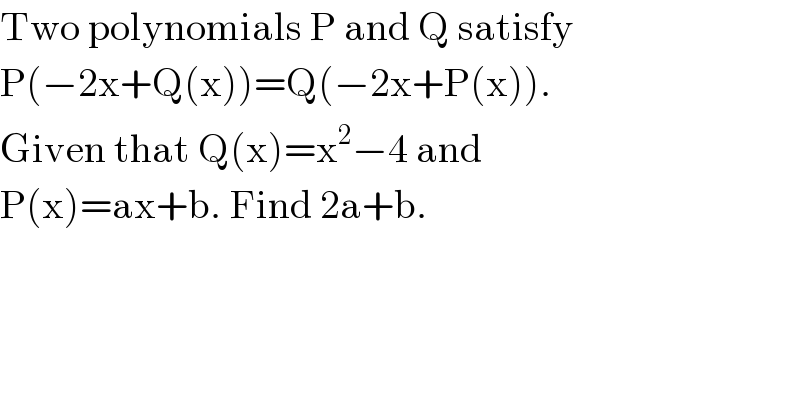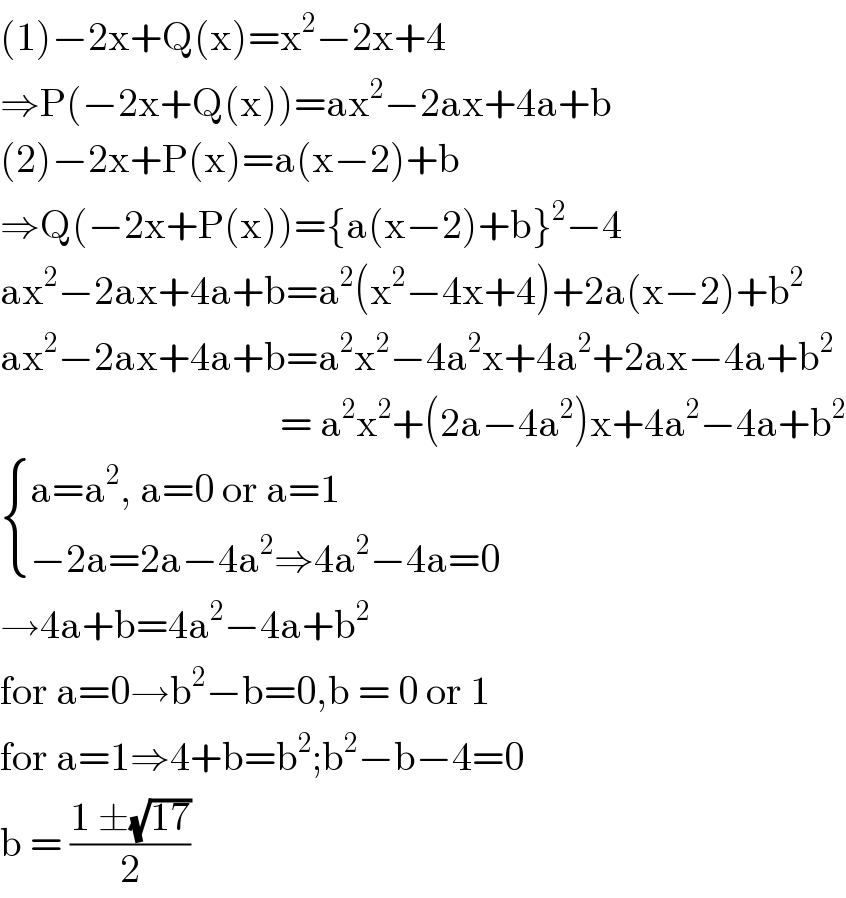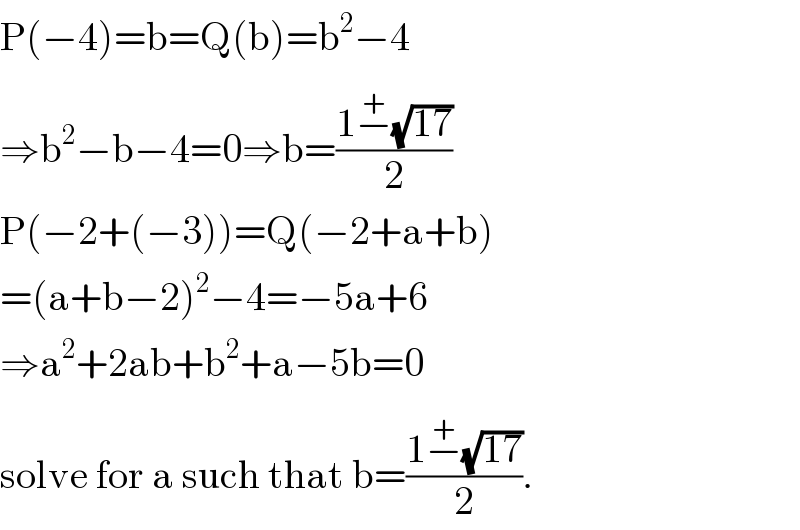Question Number 110675 by Aina Samuel Temidayo last updated on 30/Aug/20

$$\mathrm{Two}\:\mathrm{polynomials}\:\mathrm{P}\:\mathrm{and}\:\mathrm{Q}\:\mathrm{satisfy} \\ $$$$\mathrm{P}\left(−\mathrm{2x}+\mathrm{Q}\left(\mathrm{x}\right)\right)=\mathrm{Q}\left(−\mathrm{2x}+\mathrm{P}\left(\mathrm{x}\right)\right). \\ $$$$\mathrm{Given}\:\mathrm{that}\:\mathrm{Q}\left(\mathrm{x}\right)=\mathrm{x}^{\mathrm{2}} −\mathrm{4}\:\mathrm{and} \\ $$$$\mathrm{P}\left(\mathrm{x}\right)=\mathrm{ax}+\mathrm{b}.\:\mathrm{Find}\:\mathrm{2a}+\mathrm{b}. \\ $$
Answered by bemath last updated on 30/Aug/20

$$\left(\mathrm{1}\right)−\mathrm{2x}+\mathrm{Q}\left(\mathrm{x}\right)=\mathrm{x}^{\mathrm{2}} −\mathrm{2x}+\mathrm{4} \\ $$$$\Rightarrow\mathrm{P}\left(−\mathrm{2x}+\mathrm{Q}\left(\mathrm{x}\right)\right)=\mathrm{ax}^{\mathrm{2}} −\mathrm{2ax}+\mathrm{4a}+\mathrm{b} \\ $$$$\left(\mathrm{2}\right)−\mathrm{2x}+\mathrm{P}\left(\mathrm{x}\right)=\mathrm{a}\left(\mathrm{x}−\mathrm{2}\right)+\mathrm{b} \\ $$$$\Rightarrow\mathrm{Q}\left(−\mathrm{2x}+\mathrm{P}\left(\mathrm{x}\right)\right)=\left\{\mathrm{a}\left(\mathrm{x}−\mathrm{2}\right)+\mathrm{b}\right\}^{\mathrm{2}} −\mathrm{4} \\ $$$$\mathrm{ax}^{\mathrm{2}} −\mathrm{2ax}+\mathrm{4a}+\mathrm{b}=\mathrm{a}^{\mathrm{2}} \left(\mathrm{x}^{\mathrm{2}} −\mathrm{4x}+\mathrm{4}\right)+\mathrm{2a}\left(\mathrm{x}−\mathrm{2}\right)+\mathrm{b}^{\mathrm{2}} \\ $$$$\mathrm{ax}^{\mathrm{2}} −\mathrm{2ax}+\mathrm{4a}+\mathrm{b}=\mathrm{a}^{\mathrm{2}} \mathrm{x}^{\mathrm{2}} −\mathrm{4a}^{\mathrm{2}} \mathrm{x}+\mathrm{4a}^{\mathrm{2}} +\mathrm{2ax}−\mathrm{4a}+\mathrm{b}^{\mathrm{2}} \\ $$$$\:\:\:\:\:\:\:\:\:\:\:\:\:\:\:\:\:\:\:\:\:\:\:\:\:\:\:\:\:\:\:\:\:\:\:=\:\mathrm{a}^{\mathrm{2}} \mathrm{x}^{\mathrm{2}} +\left(\mathrm{2a}−\mathrm{4a}^{\mathrm{2}} \right)\mathrm{x}+\mathrm{4a}^{\mathrm{2}} −\mathrm{4a}+\mathrm{b}^{\mathrm{2}} \\ $$$$\begin{cases}{\mathrm{a}=\mathrm{a}^{\mathrm{2}} ,\:\mathrm{a}=\mathrm{0}\:\mathrm{or}\:\mathrm{a}=\mathrm{1}}\\{−\mathrm{2a}=\mathrm{2a}−\mathrm{4a}^{\mathrm{2}} \Rightarrow\mathrm{4a}^{\mathrm{2}} −\mathrm{4a}=\mathrm{0}}\end{cases} \\ $$$$\rightarrow\mathrm{4a}+\mathrm{b}=\mathrm{4a}^{\mathrm{2}} −\mathrm{4a}+\mathrm{b}^{\mathrm{2}} \\ $$$$\mathrm{for}\:\mathrm{a}=\mathrm{0}\rightarrow\mathrm{b}^{\mathrm{2}} −\mathrm{b}=\mathrm{0},\mathrm{b}\:=\:\mathrm{0}\:\mathrm{or}\:\mathrm{1} \\ $$$$\mathrm{for}\:\mathrm{a}=\mathrm{1}\Rightarrow\mathrm{4}+\mathrm{b}=\mathrm{b}^{\mathrm{2}} ;\mathrm{b}^{\mathrm{2}} −\mathrm{b}−\mathrm{4}=\mathrm{0} \\ $$$$\mathrm{b}\:=\:\frac{\mathrm{1}\:\pm\sqrt{\mathrm{17}}}{\mathrm{2}} \\ $$
Commented by Aina Samuel Temidayo last updated on 30/Aug/20

$$\mathrm{Thanks}\:\mathrm{but}\:\mathrm{with}\:\mathrm{the}\:\mathrm{options}\:\mathrm{I}\:\mathrm{have} \\ $$$$\mathrm{here},\:\mathrm{the}\:\mathrm{answer}\:\mathrm{should}\:\mathrm{be}\:\mathrm{an}\:\mathrm{integer}. \\ $$
Commented by bemath last updated on 30/Aug/20

$$\mathrm{what}\:\mathrm{reason}\:\mathrm{the}\:\mathrm{answer}\:\mathrm{should}\:\mathrm{be}\:\mathrm{integer}?\:\mathrm{given}\:\mathrm{di}\:\mathrm{condition}? \\ $$
Commented by Aina Samuel Temidayo last updated on 30/Aug/20

$$\mathrm{I}\:\mathrm{don}'\mathrm{t}\:\mathrm{understand} \\ $$
Commented by floor(10²Eta[1]) last updated on 30/Aug/20

$$\mathrm{Q}\left(\mathrm{x}\right)=\mathrm{x}^{\mathrm{2}} −\mathrm{4}\:\mathrm{so}\:\mathrm{why}\:\mathrm{Q}\left(\mathrm{x}\right)−\mathrm{2x}=\mathrm{x}^{\mathrm{2}} −\mathrm{2x}+\mathrm{4}? \\ $$$$\mathrm{you}\:\mathrm{also}\:\mathrm{did}\:\left\{\mathrm{a}\left(\mathrm{x}−\mathrm{2}\right)+\mathrm{b}\right\}^{\mathrm{2}} −\mathrm{4}\:\mathrm{wrong} \\ $$
Commented by Aina Samuel Temidayo last updated on 30/Aug/20

$$\mathrm{So}\:\mathrm{can}\:\mathrm{you}\:\mathrm{solve}\:\mathrm{it}? \\ $$
Commented by bemath last updated on 30/Aug/20

$$\mathrm{why}\:\mathrm{wrong}?\:\mathrm{Q}\left(\mathrm{x}\right)=\mathrm{x}^{\mathrm{2}} −\mathrm{4}\:\mathrm{then}\: \\ $$$$\mathrm{Q}\left(\mathrm{x}\right)−\mathrm{2x}=\mathrm{x}^{\mathrm{2}} −\mathrm{4}−\mathrm{2x}=\mathrm{x}^{\mathrm{2}} −\mathrm{2x}−\mathrm{4} \\ $$$$\mathrm{clear} \\ $$
Commented by floor(10²Eta[1]) last updated on 30/Aug/20

$$\mathrm{that}\:\mathrm{is}\:\mathrm{not}\:\mathrm{what}\:\mathrm{you}\:\mathrm{type}\:\mathrm{on}\:\mathrm{the}\:\mathrm{resolution} \\ $$
Answered by Aziztisffola last updated on 30/Aug/20

$$\mathrm{P}\left(−\mathrm{4}\right)=\mathrm{b}=\mathrm{Q}\left(\mathrm{b}\right)=\mathrm{b}^{\mathrm{2}} −\mathrm{4} \\ $$$$\Rightarrow\mathrm{b}^{\mathrm{2}} −\mathrm{b}−\mathrm{4}=\mathrm{0}\Rightarrow\mathrm{b}=\frac{\mathrm{1}\overset{+} {−}\sqrt{\mathrm{17}}}{\mathrm{2}} \\ $$$$\mathrm{P}\left(−\mathrm{2}+\left(−\mathrm{3}\right)\right)=\mathrm{Q}\left(−\mathrm{2}+\mathrm{a}+\mathrm{b}\right) \\ $$$$=\left(\mathrm{a}+\mathrm{b}−\mathrm{2}\right)^{\mathrm{2}} −\mathrm{4}=−\mathrm{5a}+\mathrm{6} \\ $$$$\Rightarrow\mathrm{a}^{\mathrm{2}} +\mathrm{2ab}+\mathrm{b}^{\mathrm{2}} +\mathrm{a}−\mathrm{5b}=\mathrm{0} \\ $$$$\mathrm{solve}\:\mathrm{for}\:\mathrm{a}\:\mathrm{such}\:\mathrm{that}\:\mathrm{b}=\frac{\mathrm{1}\overset{+} {−}\sqrt{\mathrm{17}}}{\mathrm{2}}. \\ $$
